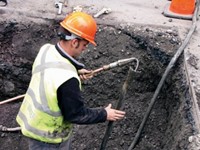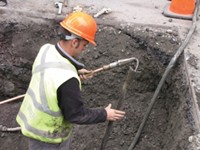Advertisement
Grab your lab coat. Let's get started
Welcome!
Welcome!
Create an account below to get 6 C&EN articles per month, receive newsletters and more - all free.
It seems this is your first time logging in online. Please enter the following information to continue.
As an ACS member you automatically get access to this site. All we need is few more details to create your reading experience.
Not you? Sign in with a different account.
Not you? Sign in with a different account.
ERROR 1
ERROR 1
ERROR 2
ERROR 2
ERROR 2
ERROR 2
ERROR 2
Password and Confirm password must match.
If you have an ACS member number, please enter it here so we can link this account to your membership. (optional)
ERROR 2
ACS values your privacy. By submitting your information, you are gaining access to C&EN and subscribing to our weekly newsletter. We use the information you provide to make your reading experience better, and we will never sell your data to third party members.
Polymers
Plastic or Metal Pipes: Pros and Cons
October 22, 2007
| A version of this story appeared in
Volume 85, Issue 43
The Plastics Pipe Institute is the major trade association representing all segments of the plastics pipe industry in North America. For more than 50 years, our members have been involved in the research and advancement of plastic pipe and the promotion of its benefits throughout the world. I was both surprised and disappointed after reading an article by Bethany Halford (C&EN Latest News, "Plastic Plumbing Can Make Water Nasty," Aug. 24) based on a study done by Andrea Dietrich, a researcher at Virginia Tech.
Starting with the title of the brief and carrying through many of the comments in the report, the choice of words tend to shed a negative light on the use of plastic pipe in drinking-water systems. Since C&EN is a publication covering multiple aspects of chemistry, I was quite surprised by the lack of research taken before writing this piece and disappointed by the lack of balance by not comparing plastic pipe to more traditional metal pipe. After reading the article, one can easily come away with the negative impression that only plastic pipe imparts tastes and odors to water, leading to unfounded fear in its use.
As a case in point, while copper has been a material widely used in the U.S. to move drinking water, the fact that copper pipes can deliver a highly metallic taste to water, which can become particularly potent and even toxic when those pipes begin to deteriorate, was excluded. This comes from a study also done by Virginia Tech researchers in 2006.
Generally, all piping systems can impart some taste and odor traits to water. Widely accepted best practices recommend the flushing of all lines and piping systems prior to implementing them for regular consumptive use; any taste or odor characteristics resulting from inactive lines or new installations are quickly and easily remedied through such activity.
What was missing from the article, and from Dietrich's report, was commentary on the substantial economic and health benefits that come from the use of plastic pipe over conventional metal pipes. These two points are the heart of why, as Halford mentions in her article "plastic has started to replace metal as the material of choice for water pipes."
A. (Tony) Radoszewski
Executive Director
Plastics Pipe Institute
Irving, Texas





Join the conversation
Contact the reporter
Submit a Letter to the Editor for publication
Engage with us on Twitter